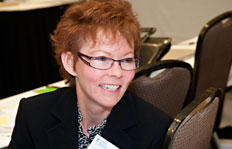 Wendy Tink, a family physician and clinical assistant professor at the University of Calgary Faculty of Medicine, is asking family medicine residents whether they believe their patients suffered from childhood trauma.
Wendy Tink, a family physician and clinical assistant professor at the University of Calgary Faculty of Medicine, is asking family medicine residents whether they believe their patients suffered from childhood trauma.
So far, fewer than 10 percent of those she’s queried believe that their male patients suffered from childhood trauma, and less than 20 percent believe that their female patients did. And yet, the CDC-Kaiser Permanente Adverse Childhood Experiences Study (ACE Study), as well as many other ACE surveys, show that two-thirds of the population – 62 percent of men and 65 percent of women -- has experienced childhood trauma. And ACEs are the most important predictor of adult chronic disease and mental illness.
“Our profession has work to do to increase knowledge and clinical practice in this area of child adversity and effects on both male and female adult health,” says Tink. “It appears knowledge gaps may be particularly influencing practice and we are letting down our men.”We are letting down our men,” she maintains.
The goal of Tink’s ongoing study, funded by the Palix Foundation, formerly known as the Norlien Foundation in Alberta, Canada, is to identify how the residents’ knowledge, skills and attitudes about childhood trauma influenced adult patient care.
“In developing the next generation of family physicians,” explains Tink, “it’s important to study the resident population and ensure graduates have confidence and skills to recognize and care for patients with these histories."
Ever since Dr. Vincent Felliti’s seminal research at Kaiser Permanente that led to his partnership with Dr. Robert Anda and the CDC, evidence has been mounting that ACEs not only affects a person’s physical and mental health but also can lead to unhealthy behaviors, such as substance abuse, overeating, smoking, sexual transmitted diseases, and multiple teenage pregnancies. In turn, these result in higher emergency and office visits, surgeries, and prescriptions.
“Childhood trauma is discussed in medical school, but there appears to be little formal education in residency education about how to apply this knowledge into practice,” says Tink.
A main reason doctors don’t ask is a lack of confidence, according to Tink, whose video about addressing gaps in physician knowledge of ACEs health consequences was sponsored by the Association of Faculties of Medicine of Canada. At least half of all the doctors in her study said they didn’t feel confident enough to ask their patients about their past childhood experiences.
Gentle, caring, nonjudgmental inquiry about childhood trauma strengthens the doctor-patient relationship and increases the likelihood that patients will disclose if asked, according to Dr. Marie Lussier at the University of Montreal, in an article, “Should family physicians be empathetic?” published in Canadian Family Physician on June 10, 2008.
“Patients being able to say -- ‘This happened to me’ -- offers amazing relief to patients,’” explains Tink.
That’s also been the experience of many pediatricians who are beginning to integrate the ACE questions in their practices.
In her own practice, Tink prefers to not to use the word “abuse” when asking her patients about trauma. Although she doesn’t use the 10-point ACE questionnaire routinely in her own clinical practice, if patient discussion triggers a suggestion of childhood trauma, she might frame her questions in a personalized ways. Here are a couple of examples:
- “This may seem like an odd question to you, but what relationship did you have with anger or alcohol growing up?” Or,
- “How was growing up for you, particularly fearful events?”
Tink’s analysis of residents’ understanding of childhood trauma study is ongoing. In the meantime, she and her team will continue to incorporate their findings into patient care and resident teaching.
She and her study partners, Dr. Martina Kelly and Jessica Tink, aim to develop physician confidence about when to suspect ACEs, why this might be important, how to skillfully talk with patients about ACEs, and which treatments to consider in order to alter unhealthy behaviors and beliefs….or simply to create space for the patient to share a secret with a trusted family physician.



Comments (5)